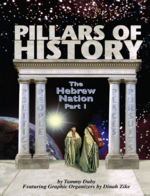Pillars of History is a highly-visual, hands-on approach for studying the Old Testament for students in kindergarten through eighth grade. It should work well as a family resource as parents select from among the various activities those most suitable for each child.
Author Tammy Duby has teamed up with Dinah Zike, incorporating Dinah's 3D Graphic Organizers into every lesson as students read from and discuss Scripture; create a timeline, map book, and prayer journal; and memorize Scripture verses. Older students can expand by completing activities from the suggestions under “Experiences, Investigations, and Research” for each lesson.
The format of the book is in many ways similar to that of the Great Science Adventures series (also from Common Sense Press) that also incorporates Dinah Zike's 3D Graphic Organizers. Everything is contained in one book. There are no separate student books. The beginning of the book teaches how to create the various organizers by cutting, folding, and taping paper. Approximately half the pages in the book are pre-printed to be used for creating the organizers. Some of these are simple folded booklets, but others get into more complex cutting, folding, and layering to make organizers of all sorts of shapes and configurations—they are quite creative. You may photocopy these for the students in your family or class. Alternatively, some students might wish to create their own designs once they understand how the various organizers work.
The organizers provide visual material for students to read and review. The “arts and crafts” aspect of creating them is likely to make them especially appealing as a learning tool for some children. You can view a sample lesson at the publisher's website to judge how well this approach will work for your students.
I reviewed the first of what should eventually be a two-book series that covers the entire Old Testament. The first book is subtitled The Hebrew Nation, Part I. There are 24 lessons in Part I covering the creation in Genesis 1 through Joshua 10. One story is highlighted in each lesson, so this is not comprehensive Bible study, but it is a chronological study that will help students grasp the historical timeline of the Bible. Each lesson might take up to a week to complete depending which activities you select and how long you spend on some of them. Younger children will likely spend much less time than older and will certainly do fewer of the activities. Activities are coded to show those recommended for different levels.
Three appendices provide instructions for three large projects that are optional: “Host a Palestine Party,” “Make a Hebrew Village,” and “Make a Model Tabernacle.”
Some map-related activities require the use of an atlas, but other than that the Bible is your primary “text.” Research suggestions for older students might require additional reference books or internet access.
Parent/teacher lesson presentation is essential, although preparation time is minimal since so much is supplied for you within the book. You will likely need to photocopy some pages and gather basic materials such as scissors, glue, markers, and tape. You begin each lesson by reading and discussing the Scripture passage. From that point, your choice of the various activities as well as the age and ability of each child will determine how much parent/teacher involvement is needed. There is no answer key, so parents/teachers need to be familiar enough with Scripture to evaluate student responses, whether in discussions or written activities.
Children who especially enjoy the arts-and-crafts hands-on activities should find this an enjoyable way to learn Bible history.










